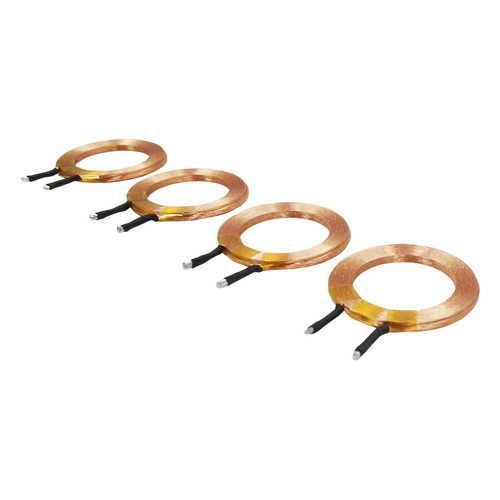The smart watch coil is one of the essential core components in modern smart wearable devices, and its unique performance design and compact structure ensure efficient charging and stable signal transmission. As a miniaturized electronic device, smartwatches have strict requirements for the structure, materials, anti-interference ability, and transmission efficiency of the coil. This article will analyze in detail the characteristics and advantages of smart watch coils from five aspects: miniaturization design, electromagnetic compatibility, transmission performance, heat dissipation management, and applicable materials, to help better understand their critical role in smart watch applications.
The coil of smart watches is particularly prominent in miniaturization design. Smart watches have a small size and require all internal components to be kept compact to ensure that the device is lightweight and suitable for wearing. To achieve this miniaturization, the coil will be designed with multi-layer windings and precision manufacturing processes to reduce volume and improve space utilization. Meanwhile, miniaturization design requires coils to maintain efficient electromagnetic conductivity in extremely small volumes, making the number of turns and layout of smartwatch coils a core consideration. Through advanced automated precision winding technology, smart watch coils can achieve tight and effective winding configuration in a limited space, ensuring uniform distribution of electromagnetic fields and improving their transmission performance and service life.
The anti electromagnetic interference ability of smart watch coils is an important performance characteristic. As a key component for wireless charging and signal transmission, smart watch coils need to have anti-interference design to avoid interference during frequent signal transmission. Smart watch coils typically use a double-layer winding structure and high-quality shielding materials to reduce the impact of external electromagnetic waves on the charging process, thereby maintaining charging stability. Anti interference design can improve the performance of the coil in signal reception and data transmission, while also ensuring the stable use of the smartwatch in different environments. The high anti-interference performance enables the smart watch coil to remain stable in complex electromagnetic environments, which is crucial for its practical application.

The transmission performance of smart watch coils is directly related to the charging speed and signal response time of the device. Wireless charging is a major feature of smartwatches, and the smartwatch coil is the core component that achieves this function. Smart watch coils are typically made of materials with high conductivity, such as high-quality copper wire or silver plated wire, ensuring efficient energy transfer during the charging process. In order to further optimize transmission performance, the selection of magnetic conductive materials will be increased in coil design to improve its electromagnetic conversion efficiency, thereby achieving efficient and fast wireless charging. In addition, in terms of signal transmission, the smart watch coil needs to maintain low signal loss to support precise positioning and real-time data transmission of the device.
The heat dissipation management design of the smartwatch coil is the key to ensuring its stable operation. During wireless charging, the coil generates a certain amount of heat due to electromagnetic conversion, so the quality of heat dissipation directly affects the charging efficiency and the service life of the device. Smart watch coils are usually made of materials with high thermal conductivity, and thermal management optimization is carried out in the design, such as adding thermal conductivity pads or heat dissipation coatings to ensure rapid heat dissipation. This optimized heat management not only improves the charging efficiency of the smartwatch coil, but also reduces the impact of high temperatures on other internal components of the watch, extending the service life of the smartwatch.
The material selection for smartwatch coils needs to balance conductivity, magnetism, and reliability. To meet the requirements of efficient transmission and durability, smart watch coils often use highly conductive materials such as silver plated copper wire and nickel plated copper wire. At the same time, attention is paid to selecting magnetic core materials with good magnetic conductivity to improve the uniformity of the electromagnetic field and charging efficiency. The performance of coils made of different materials in charging and signal transmission varies, and engineers will choose the most suitable material based on the design requirements of the smartwatch. Through reasonable material selection and optimized processes, smart watch coils not only ensure performance, but also achieve high production economy and quality stability.
Overall, smartwatch coils have shown significant advantages in miniaturization design, electromagnetic interference resistance, transmission efficiency, heat dissipation management, and material selection. As a key component in smartwatches, the coil achieves efficient wireless charging, stable data transmission, and long service life through precise design and strict manufacturing processes. With the rapid development of smart wearable technology, the design and material application of smart watch coils are constantly innovating to better meet the needs of device miniaturization and multifunctionality. In the future, smart watch coils will further improve in transmission efficiency and environmentally friendly materials, bringing better user experience and market competitiveness to smart wearable devices.